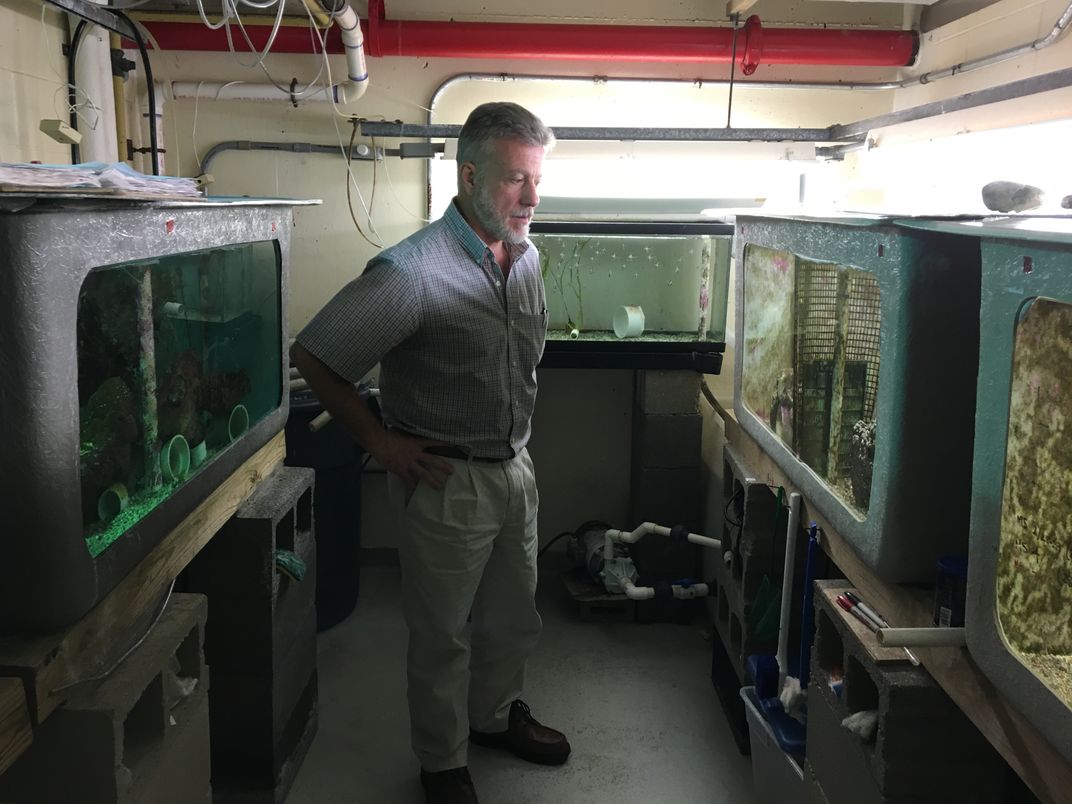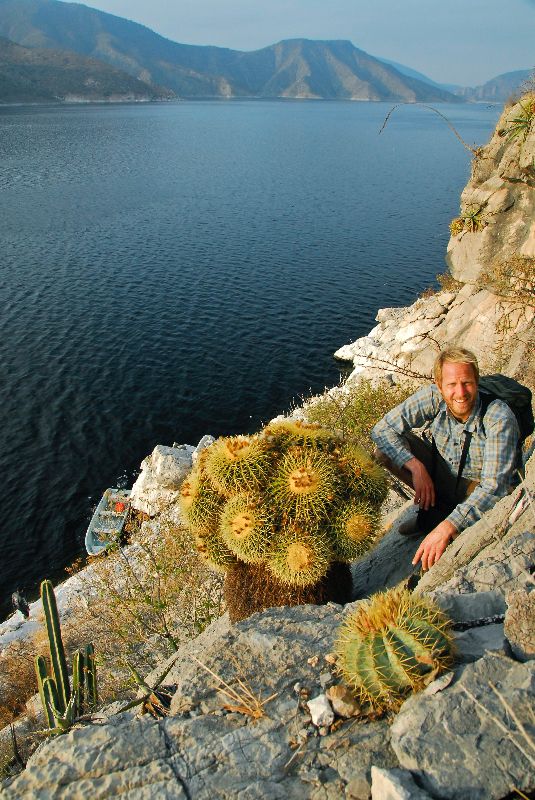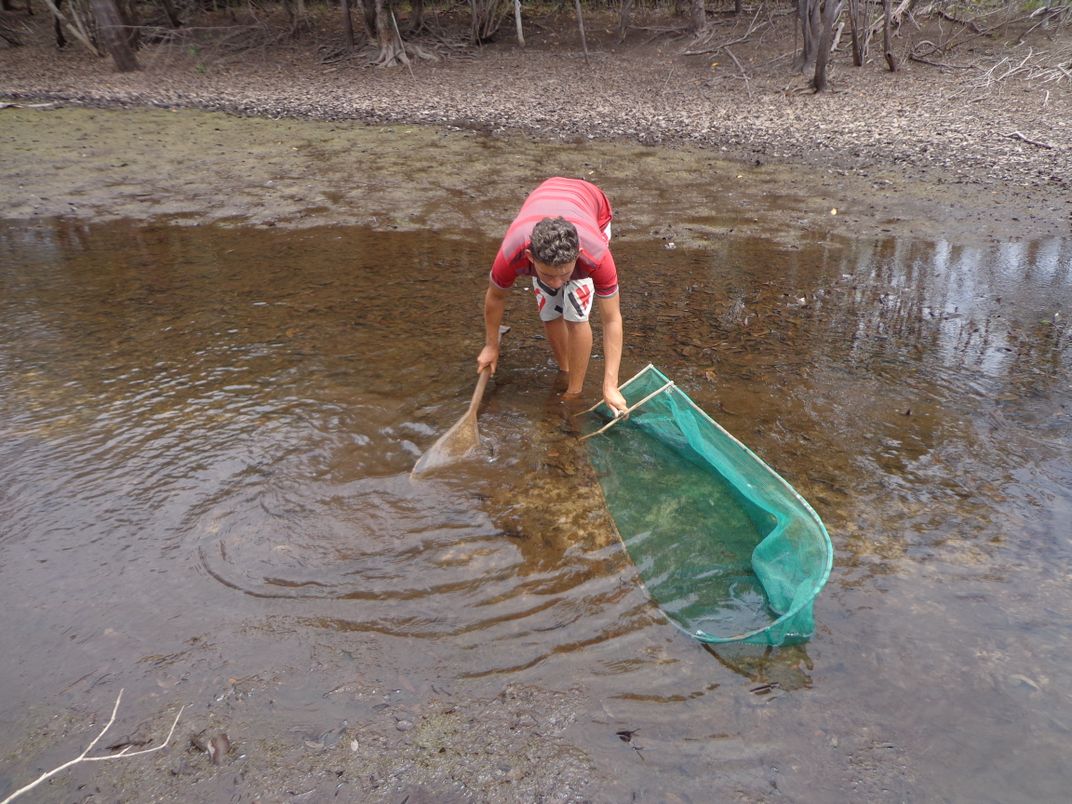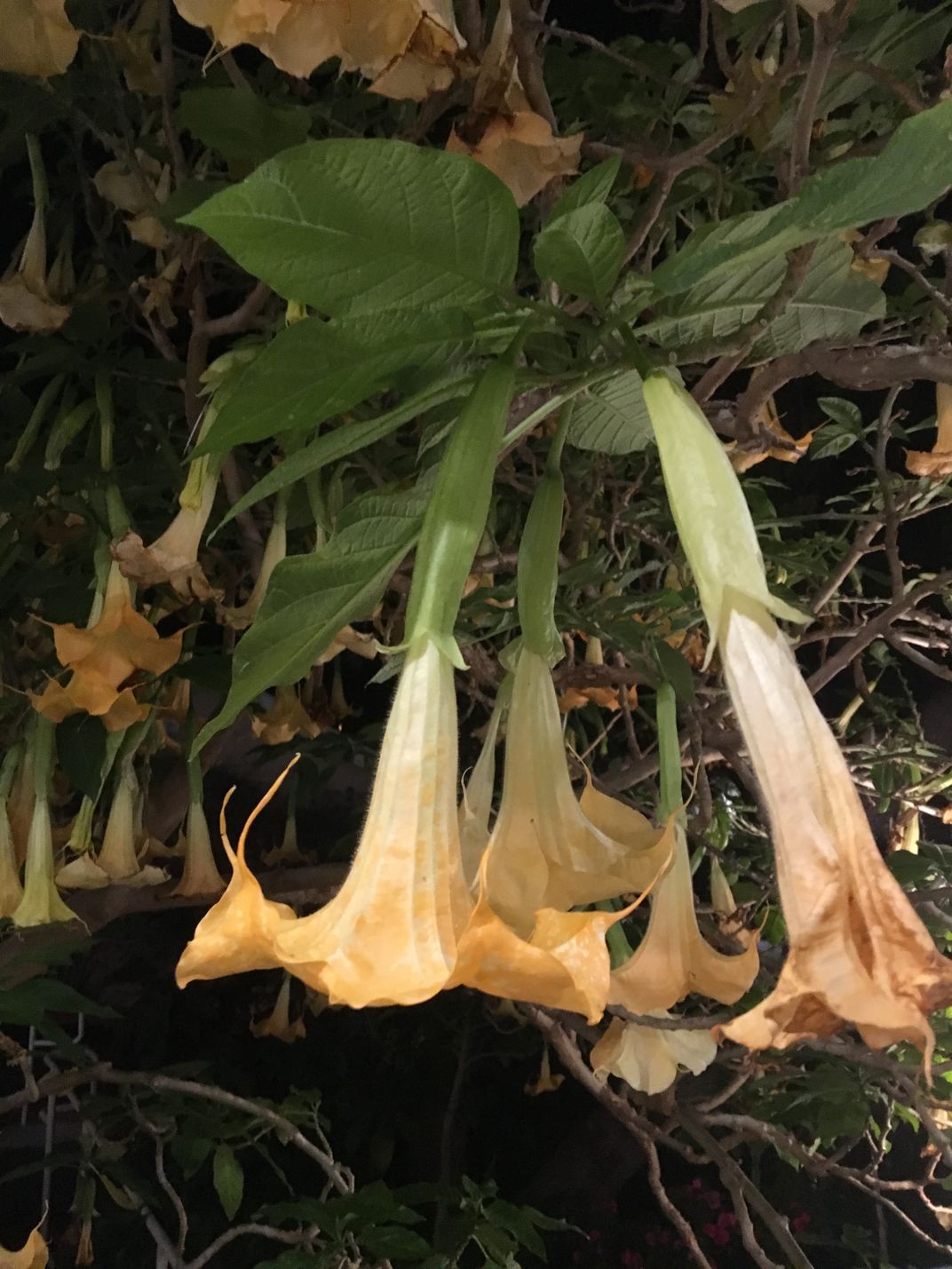Why You Can Walk Into a Store and Buy a Nearly Extinct Animal
By commercializing species, humans wield a far bigger influence than they think over the fate of wild plants and animals
/https://tf-cmsv2-smithsonianmag-media.s3.amazonaws.com/filer/46/36/4636ddfc-de41-4c1b-b659-e274b011a6a9/bk8ak2_2.jpg)
Thirty years ago, almost no one had heard of the Banggai cardinalfish. This elegant species, with its white spots that seem to glow against its curving black fins, was only found in isolated pockets scattered throughout Indonesia’s Banggai archipelago. In 1994, prominent ichthyologist Gerry Allen happened across it on an expedition in Indonesia, and made the fateful decision to introduce it to the United States.
The fish’s graceful form and striking pattern quickly attracted the attention of hobby aquarists. “The fish became popular in the aquarium trade overnight,” says Alex Vagelli, director of science and conservation at the Center for Aquatic Sciences at Adventure Aquarium. By 2016, the cardinalfish’s population dropped 93 percent, he says. Vagelli has devoted the past two decades to studying this species, which fascinates scientists as much as it appeals to collectors.
The Banggai cardinalfish, it turns out, has unusual reproductive habits. Most fish release hundreds to thousands of eggs at a time, letting ocean currents carry them as they develop into larvae and mature into proper fish. In contrast, the Banggai cardinalfish produces only a few dozen large eggs, which the male keeps in his mouth. The fish hatch as fully-formed, miniature adults—completely skipping the larval stage most fish go through, says Vagelli.
After five years studying the fish in the lab, Vagelli first visited the then-remote Banggai islands in 2001. He discovered that the Banggai’s breeding habits keep them from straying too far from where they are born—which makes them particularly vulnerable to over-collection. The fish are unlikely to recolonize areas that have been hit hard by fishermen, and even if they do, they won’t bring back the genetic diversity that was lost when the site’s original inhabitants disappeared, he says.
Yet the extent of collection for the aquarium trade hadn’t really hit him until one day in 2004, when he was diving off South Banggai Island. “I spent maybe the whole morning tagging one population just to keep working with these fishes,” Vagelli tells me, “and all of a sudden I have all these canoes above my head.” Locals had spotted Vagelli’s boat, which they thought carried foreign collectors from Bali. “They jumped into the water thinking that I was collecting the fish, so they wanted to get it first,” he says.
“I guess at some point in the United States and Europe, [in] some pet shops there were some fishes with a little bright red tag on the side,” Vagelli says, referring to the tag he uses to mark the fish. The joke was clearly an attempt to mask how upset he was, even 13 years later. In one day the entire lineage of that reef had been wiped out. By 2004, 90 percent of the wild population of Banggai cardinalfish had disappeared.
And yet, if you live in the U.S., you’ll have little trouble buying the cardinalfish at your local pet store. Between 700,000 and 1.4 million cardinalfish arrived in the U.S in 2001, according to a report by the National Oceanic and Atmospheric Administration. By 2012, this number was closer to 120,000. Since then, aquaculture operations in Thailand have accounted for a significant portion of imported cardinalfish, but collection from the wild continues.
And the Banggai cardinalfish is merely one example of a species that can be found in abundance on store shelves while its counterparts in the wild face a precarious future. The Java sparrow, red line torpedo barb, and Vulcan palm are all widely available commercially despite their poor situation in the wild. The smiling pink amphibian known as the axolotl is hugely popular as a pet, but in the wild has dwindled down to just one poulation in Lake Xochimilco, outside Mexico City.
The effect on these species can be either good or bad for their survival—but what’s for sure is that humans, by coveting these commercial species, are deeply impacting wild populations without realizing it.

Separate Trajectories
The relationship between wild and commercial populations can be complex. Sometimes, the two end up on separate trajectories. Exhibit A: the golden barrel cactus. The knee-high succulent is ubiquitous in gardens and landscapes throughout the western United States. Its attractive shape and hardiness have made it a favorite among landscapers, gardeners, and homeowners putting in drought tolerant yards. You can buy it just about anywhere.
It’s also an endangered species. Until the discovery of a second population in 2005, it was known from only a single wild location in central Mexico.
The cactus, known among scientists as Echinocactus grusonii, is a small yet robust cactus native to the Chihuahuan Desert in central Mexico. They can grow to 4.25 feet tall, but most individuals available for purchase range from baseball to watermelon-size. The cactus lives up to its name—its bright yellow spines and nearly spherical shape make it a perfect focal point in a garden.
“Everything that looks like gold has a special charm for humans,” says Emiliano Sanchez, the director of the Cadereyta Regional Botanical Garden in Querétaro, Mexico. I chuckle at Sanchez’s line of reasoning, but he continues: “you may laugh at it, but it is one of the most [sought after] plants.”
The botanic garden where Sanchez works is less than 25 miles from Infiernillo Canyon, where the golden barrel cactus naturally grows. The canyon spans a section of the border between the Mexican states of Querétaro and Hidalgo. The cactus was never particularly widespread, according to Sanchez, and historical collection for the plant trade likely impacted the population. But there is no way of knowing for certain, because any evidence that once existed has been wiped out.
It vanished as a result of the Zimapán Dam project, which the Mexican government and the Federal Electricity Commission (FEC) undertook to provide power and irrigation to the region and as part of the country’s entry into the North American Free Trade Agreement, also known as NAFTA. In September 1996, when the dam was finished, the authorities flooded Infiernillo Canyon and three local villages were buried underwater. “The habitat disappeared,” says Beatriz Maruri, the garden’s scientific research coordinator.
Sanchez estimates there are perhaps 1,000 golden barrel cactuses in the remaining 12.5 miles of habitat left downstream. According to Rafael Ortega Varela, a staff biologist with the FEC, 50 percent of the cactus’ habitat was lost. However, since the discipline of ecology was still relatively young in Mexico at that time, no population study had been done beforehand, so this is only a rough estimate.
In contrast to its rarity in the wild, the E. grusonii grows quite well in cultivation. “If you had two plants of golden barrels flowering, you could make enough seeds to cover the world with golden barrels,” says Kelly Griffin, the succulent development manager at Altman Plants. You may not have heard of the company, but you’re likely familiar with Griffin’s handiwork. It’s his job to find, or breed, new, exciting varieties of cactuses and other succulents, which Altman sells to retail giants like Home Depot, Lowes, and Walmart.
The golden barrel cactus readily grows from seeds, according to Griffin, which the cactus produces in the thousands. What’s more, commercial lab techniques allow Griffin to produce 10,000 plants in the span of a couple years from tissue cut from a single individual. He can even leave the original plant in the wild. “You basically need as much material as what a grasshopper would eat in an afternoon,” Griffin remarks.
This is a very good thing for the golden barrel. “We let people grow plants, that are propagated artificially, … and they don’t have to go out in the wild [to collect them],” says Griffin. And why would you risk harm, hassle, and arrest collecting the plants from the wild when you can buy one for $2.50, he adds.
Sanchez echoes this sentiment. “You can get a grusonii plant almost any place in the planet, and at a good price,” he says. “It’s not difficult to propagate the plant, and this takes pressure [away] from the plants that grow in the habitat.”
Breeding facilities have saved myriad species from extinction by overzealous admirers willing to pay top dollar to bring them into their homes. However, maintaining a captive population is not sufficient to protect a species, and it doesn’t alleviate other pressures put on wild populations.

A Mixed Bag
While successful breeding operations can reduce collection pressures on wild populations, creating a steady, artificial supply of plants and animals can divert money and attention away from other threats facing the species, like pollution and habitat loss. Take the red-tailed black shark, a small carp from Thailand that has been ubiquitous in the freshwater aquarium trade for decades. Because the fish is easy to raise in captivity, it wasn’t subjected to heavy collection.
Unfortunately, this also prevented wild black sharks from reaping the benefits of their popularity. Construction of numerous dams across Thailand in the 1970s fragmented the fish’s habitat, according to the International Union for Conservation of Nature, which compiles the Red List of Threatened Species. Pollution, infrastructure, and agriculture gradually degraded and restricted the fish’s habitat until the species all but disappeared from the wild. Scientists listed the black shark as extinct in the wild in 1996, and only recently discovered a small population in 2014.
Some say conservationist efforts should take advantage of these species’ popularity. “You have to say, ‘okay, what can trade do to ensure that habitat is being maintained,’” says Andy Rhyne, a biologist who studies the aquarium trade at Roger Williams University. One strategy is to leverage demand to promote sustainable collection.
With proper management and oversight, collecting native species can create incentives for local communities to preserve native habitats. In 1991, conservation biologist and amateur aquarist Scott Dowd embarked on a trip to Barcelos, a municipality along the Rio Negro in northern Brazil, to see some of his aquarium fish in their natural habitat. “It was a very moving conclusion,” he tells me, “that the hobby that I had been in for my whole life was responsible for taking an excessive amount of animals from the rainforest.”
“As it turned out though, that was completely wrong,” he says.
The Rio Negro is home to more than 100 species sold in the aquarium trade, according to Freshwater Ecoregions of the World, a collaborative biodiversity database project. Collection for the aquarium hobby accounts for roughly 60 percent of the Barcelos’ revenue, says Dowd. The fishery is dominated by the vibrant blue and red cardinal tetra, which accounts for over 85 percent of the number of fish exported from the region, Dowd says. But the fishery poses little threat to the small fish due to its particular life cycle.
The Rio Negro swells and recedes by roughly 33 ft over the course of the year. Young tetras have access to the flooded forest and all the food it contains. But these are temporary conditions. As space and food decline over the year, and the concentration of predators increases, most of the tetras will die, Dowd says. The few that survive reproduce in incredible numbers, starting the cycle over as March approaches and the river once again swells. Collection occurs in tandem with the seasonal cycles of the river, so most of the fish being collected would have died otherwise, Dowd says.
Dowd belonged to a group of fish hobbyist friends that had an annual program in which they funded a scientist at the University of Amazonas in nearby Manaus, Brazil, and joined them on a research expedition. As the importance and sustainability of the fishery became more apparent, the program evolved into Project Piaba, a non-profit organization established to promote sustainable collection practices along the Rio Negro.
In 2014, Project Piaba released a manual on best handling practices to maximize the number of healthy fish that the community could sell. To make this technical document useful to the community, the organization trained local volunteers in the methods detailed in the manual. The organization provides them with material, tablets, and projectors and entrusts them to adapt the information for the fishing communities of Barcelos and nearby Santa Isabel do Rio Negro, as well as for exporters in the state capital of Manaus.
Although the cardinal tetra itself is not endangered, or even threatened, the fishery surrounding it ultimately protects plants and animals that are. “When there’s poverty, and there’s hunger, [and lost hope], it’s a very dangerous situation for the environment, because human instinct is to do whatever you need to do to cover yourself and your children,” says Dowd. The people in the region remember life before the hobby came in the 1950s, and transformed a love of fish into cash revenue, which ultimately manifests itself as food, and hope.
Now, the communities have a steady income and don’t have to resort to logging, mining, or slash-and-burn agriculture, explains biologist and volunteer Arnold Lugo Carvajal. What’s more, they have a vested interest in ensuring the health of not only the fish and the river, but the whole flood plain, which is particularly susceptible to dry-season fires, thanks to its peaty soil. Fires during the dry season destroy the ground and the seeds that lie dormant under it, converting the jungle to savannah. “Those fishermen, they are protecting specifically those areas that are called the Achilles’ heel of the Amazon,” says Lugo Carvajal.

Murky Records
When it comes to endangered species that are also sold commercially, it's difficult to pin down patterns. Part of the problem is that even organizations that regulate and track the trade of endangered species don’t know the full extent of this trend. “This is a relatively little known or reported problem,” says Richard Thomas, of TRAFFIC International, an NGO that monitors the trade in wild plants and animals.
In a globalized world, it's often difficult to tell where plants and animals originally come from. “We seem to have a system that waits until the trade of a species is such that they are being endangered … and then we track them,” says Rhyne. This, in turn, hamstrings efforts to manage the collection and conservation of individual species.
What’s more, according to Rhyne, reporting and regulation are still mostly based on systems developed for customs and taxes. The systems aren’t designed for conservation, “but that’s what most of the trade is tracked with,” says Rhyne.
For instance, the United Nations’ trade code for live ornamental fish is 030110. This single code encompasses every species of fish and invertebrate in the entire aquarium trade. The system makes it impossible to track fish by species: A 030110 shipment from Indonesia could contain Bangaii cardinalfish, emperor angelfish, or even moray eels.
In the age of big data and the quantified-self movement, having a single code for all ornamental fish seems laughably inadequate. Yet this archaic system, and others like it, is responsible for the fate of hundreds of species.

A Form of Success?
Native to the tropical cloud forests of South America, the angel’s trumpet planet was never a diverse genus, and its populations were never terribly robust, says Julia Dupin. “If human beings had not existed … I think Brugmansias, they would probably not have a much longer future,” says Dupin, who studied the group’s evolution and ecology at University of Colorado, Boulder.
Even so, many of the cultivated varieties are sterile hybrids, having been bred for ever more resplendent flowers at the expense of their ability to reproduce. Aggressive selection and hybridization has turned the male parts of many plants, called stamen, into an extra set of petals, creating a gorgeous but entirely useless blossom, Dupin tells me. This makes them dependent on human propagation.
“Because the majority of them are hybrids that either cannot sustain themselves or that would naturally never occur, chances are they would just die off very soon,” she says. Instead, the species are thriving at the hands of humans.
The case of angel’s trumpet raises a broader question: Even if a species thrives in cultivation, does that make it a success? Are we saving species at risk, or are we simply creating a new kind of extinction?
The environment is constantly changing, on its own and as a result of human influence. Species must adapt to these changes to survive into the future, which is why healthy wild populations are so crucial. “Evolution process cannot go on in a garden,” says Sanchez. “The plants or the population needs to be in their habitat.” That doesn’t mean you shouldn’t have plants like the angel’s trumpet or the golden barrel cactus in your garden, he adds, it simply means that we need to ensure healthy population exist in the wild as well.
One recommendation Sanchez and Maruri have for the public is to recognize and foster the species native to their area. “The native flora is the flora that lives in the place where it belongs,” says Maruri. Wherever you are you should try your best to know and help the plants where you live because those are the plants that are supposed to be there, that are adapted to be there, and that are doing their job when they’re in that place.